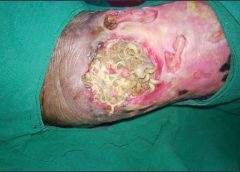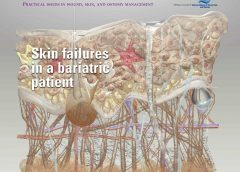http://www.medicalnewstoday.com/articles/285898.php
Read MoreSearch Results for: Sto
NAWCO News
Note from Executive Director
By Cindy Broadus, RN, BSHA, LNHA, CLNC, CLNI, CHCRM, WCC, DWC, OMS
As I write this, I am still feeling the energy from the 11th annual Wild on Wounds Conference. What a great group of wound care clinicians. With close to 1,000 attendees, the conference was fun, friendly, and jam-packed with sessions for all levels of clinicians, from beginners to advanced. Many of the attendees shared their frustrations in choosing one session over another with comments such as, “It was so difficult because of all of the great educational offerings.”
Once again, the National Alliance of Wound Care and Ostomy (NAWCO) had an answer table set up in the registration area. We enjoyed the many inquiries we received, and it was nice to put faces with names.
Each year, NAWCO gives four awards to deserving clinicians who put their hearts and souls into their work. We have so many talented and committed certified wound care clinicians that it seemed only fitting to recognize these talented people and give them the opportunity to shine. These individuals are nominated by their colleagues, coworkers, peers, and subordinates, and we had an abundance of nominations. While we would have loved to recognize all of the nominees, the committee could choose only four.
During the closing session, appropriately titled “Pay it Forward,” NAWCO recognized these four exceptionally talented, committed, hard-working clinicians for their achievements in their work with wound care patients. I wanted to share some of the impressive comments made about the award winners.
Outstanding Work in Diabetic Wounds:
Anna Ruelle, DPM, WCC
• “Voted ‘top doctor’ 11+ years in a row by peers”
• “Greatly reduced the incidence of below-the-knee amputations and loss of limb”
• “Never lets the sun set on a diabetic ulcer or wound when a patient calls.”
Outstanding Research in Wound Care:
Michael Katzman, RN, BSN, ONC, WCC
• “Known for his expertise in wound care and for being very approachable, professional, and a mentor to others”
• “Works collaboratively with other hospital skin champions to develop a protocol to prevent and treat skin tears through evidence-based research”
• “Offers regular in-services while collaborating with others to continuously improve outcomes.”
Outstanding WCC of the Year:
Chelsey Hawthorne, RN-BC, BSN, WCC
• “Serves as one of the certified nurses in a long-term care facility, and is a resource for the medical-surgical and other skilled units”
• “Works with the Magnet® Program supervisor to assist in getting more nurses certified through NAWCO”
• “Collaborates with the health system’s wound care clinic to ensure proper delivery of care to the residents.”
2014 Scholarship sponsored by Joerns® RecoverCare:
Craig Johnson, RN, BSN
• “Serves as staff nurse at a busy skilled nursing facility with a diverse and complex veteran population”
• “Demonstrates an overwhelming and sincere interest in wound care”
• “Designed and developed a mobile Wound Cart, which is used as a tool in the unit’s Wound Rounds Process.”
NAWCO is proud and honored to recognize the achievements of such a dedicated group of wound care clinicians. All of us at NAWCO congratulate the 2014 award winners.
Disclaimer: The views expressed in this article are those of the author and do not necessarily represent the views of, and should not be attributed to, Wound Care Advisor. All clinical recommendations are intended to assist with determining the appropriate wound therapy for the patient. Responsibility for final decisions and actions related to care of specific patients shall remain the obligation of the institution, its staff, and the patients’ attending physicians. Nothing in this information shall be deemed to constitute the providing of medical care or the diagnosis of any medical condition. Individuals should contact their healthcare providers for medical-related information.
Read MoreMake your patient-teaching idea a patented reality
By Joy Hooper, BSN, RN, CWOCN, OMS
Have you ever had an idea for improving patient care that you wanted to market? You may have lacked confidence or know-how, as I once did. But one patient, a crafty idea, and a trip to Walmart put me on the path to becoming a successful nurse entrepreneur. (more…)
Read MoreWhat to do when someone pushes your buttons
By Laura L. Barry, MBA, MMsc, and Maureen Sirois, MSN, RN, CEN, ANP
Why is it that some things don’t bother us, while other things catapult us from an emotional 0 to 60 mph in a heartbeat? We all know what it feels like when someone says or does something that gets our juices flowing. We feel it in our bodies, emotions, and mood. We have an overwhelming urge to react. We may express it in words at the time or take our frustrations out later on someone else. It just doesn’t feel good. We want to explode, set the record straight. (more…)
Read MoreBuilding an effective pressure ulcer prevention program
By Jeri Lundgren, BSN, RN, PHN, CWS, CWCN
As a wound care nurse, do you feel the weight of the world on your shoulders when trying to implement a pressure ulcer prevention program? Many staff members think it’s up to the wound care nurse alone to implement the program. However, a successful program requires involvement from all staff and is a 24/7 endeavor. Here’s how to do it. (more…)
Read MoreClinical Notes: Radiation & Lymphedema, Decline in Diabetic Foot Ulcers
When should we take “No” for an answer?
By: Donna Sardina, RN, MHA, WCC, CWCMS, DWC, OMS
Have you ever had a patient yell “Get out of my room!” or “Don’t touch me! I don’t want to be turned”? How about “No! Don’t put those compression stockings on my legs!” or “No, I’m not going to wear those ugly orthopedic shoes!” or “No way. I can’t stay in bed. I have to go to Bingo!”?
As clinicians, our first instinct usually is paternalistic, as if we’re the patient’s parent who knows what’s best for our child. We think, “Sorry, but you have to do this. It’s for your own good.” And we convey that idea to the patient. (more…)
Read MoreUsing maggots in wound care: Part 2
By Ronald A. Sherman, MD; Sharon Mendez, RN, CWS; and Catherine McMillan, BA
Note From the Editor: This is the second of two articles on maggot therapy. The first article appeared in our July/August 2014 issue, Read part 1 here.
Whether your practice is an acute-care setting, a clinic, home care, or elsewhere, maggot debridement therapy (MDT) can prove to be a useful tool in wound care. But setting up any new program can meet resistance—and if you seek to establish a maggot therapy program, expect to meet significant resistance. By arming yourself in advance, you can achieve your goal more easily. This article covers all the bases to help you get your maggot therapy program off the ground. (more…)
Read MoreCase study: Bariatric patient with serious wounds and multiple complications
By Hedy Badolato, RD, CSR, CNSC; Denise Dacey, RD, CDE; Kim Stevens, BSN, RN, CCRN; Jen Fox, BSN, RN, CCRN; Connie Johnson, MSN, RN, WCC, LLE, OMS, DAPWCA; Hatim Youssef, DO, FCCP; and Scott Sinner, MD, FACP
Despite the healthcare team’s best efforts, not all hospitalizations go smoothly. This article describes the case of an obese patient who underwent bariatric surgery. After a 62-day hospital stay, during which a multidisciplinary team collaborated to deliver the best care possible, he died. Although the outcome certainly wasn’t what we wanted, we’d like to share his story to raise awareness of the challenges of caring for bariatric patients. (more…)
Read More2014 Journal: November – December Vol. 3 No. 6
Ultrasound Accelerates Skin Graft Healing
Ramblings of an Itinerant Wound Care Guy
Renaissance and the New Golden Rule
by Dr. Michael Miller
To paraphrase Carol Ann from the Movie Poltergeist…”He’s Baaaaaaaaack” ! At the end of this past May, I had a sudden and disappointing parting of the ways from my prior blog host when I discovered the newest version of the Golden Rule…those that have the gold, make the rules. Is it possible to be too opinionated? Does the textual asbestos statement at the bottom of almost every web page regarding the dissociation between the hosts and the writer’s opinions really have any meaning? I am nonetheless extremely grateful to my prior hosts for allowing me the bytes to educate, illuminate and aggravate. The silent majority, mostly practitioners and patients who appreciate the inside story versus those with the gold (who don’t mind independent thinking, as long as it comes in their flavor of Kool-Aid) have both spoken.
But as PT Barnum said “’There’s no such thing as bad publicity’ and so, recognizing that more and more people are looking for a shoulder to cry on, a voice of reason, and the company that misery loves, “Ramblings of an Itinerant Wound Care Guy” re-emerges with this blog. I want to assure you that I have always relished comments and criticism both of which are proudly posted along with the blog, as long as you agree with me.
But enough fanfare and bravado and back to the bastion of wound dabblers anonymous. My three-month involuntary hiatus did little to quench the fires of indignation regarding medicine in general and wound care in particular. I had the great honor recently of meeting one of the creators of the wound care protocols for a large wound management organization. My initial disdain at our handshake turned to admiration as he explained with great pride, how the guidelines were created for diagnosis and care at their facilities. His background in wound care was impressive and his passion for care was the purest. However, in keeping with the mantra that “No Good Deed Goes Unpunished”, he related how his master plan had become intellectual oatmeal as the docs and nurses reverted to prior, Neanderthal practices. One of the major flies in his ointment was the fact that at least one facility under management had a huge number of men over 70 in treatment including hyperbarics with 100% having the diagnosis of venous insufficiency. Not a single mention of an arterial or diabetic etiology. When he brought it to the medical directors attention, the response was simply that was what had been diagnosed. He has since gone on to what he hopes are greener pastures. As far as the pitiful remnants of the wound caregivers he left behind, we agreed that they all deserve to be patient in their own centers.
To my prior readers who once again have elected to join in on the cacophony of intolerance or a newbie who on the advice of a friend decided to see what that crazy guy is writing about this month, I offer you my thanks and a promise to ignore the golden rule whenever and wherever I can. And by the way…the opinions of the statements made in this blog do not reflect those of the web site, the publisher or the editors…Got it.
Until we ramble next time.
Click here to return to Dr. Miller’s Ramblings of an Itinerant Wound Care Guy Blog page.
Disclaimer: The views expressed in this article are those of the author and do not necessarily represent the views of, and should not be attributed to, Wound Care Advisor. All clinical recommendations are intended to assist with determining the appropriate wound therapy for the patient. Responsibility for final decisions and actions related to care of specific patients shall remain the obligation of the institution, its staff, and the patients’ attending physicians. Nothing in this information shall be deemed to constitute the providing of medical care or the diagnosis of any medical condition. Individuals should contact their healthcare providers for medical-related information.
Read More


